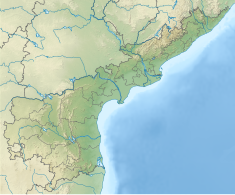| Jalaput Dam | |
|---|---|
| Country | India |
| Location | Jalaput village, Andhra Pradesh and Odisha[1] |
| Coordinates | 18°27′33″N 82°32′55″E / 18.459192°N 82.548478°E[1] |
| Purpose | Hydroelectric & Irrigation |
| Construction began | 1946[1] |
| Opening date | 1955[1] |
| Owner(s) | Governments of Andhra Pradesh and Odisha[1] |
| Dam and spillways | |
| Type of dam | Earth-fill dam |
| Impounds | Machkund River[1] |
| Height | 60.65 m (199 ft) maximum. |
| Length | 419 m (1,375 ft) |
| Spillway type | Ogee section |
| Spillway capacity | 5660 cumecs |
| Reservoir | |
| Creates | Jalaput Reservoir |
| Total capacity | 971×106 m3 (0.233 cu mi) |
| Active capacity | 893×106 m3 (0.214 cu mi) |
| Inactive capacity | 78×106 m3 (0.019 cu mi) |
| Catchment area | 1,963 km2 (758 sq mi)[1] |
| Surface area | 97.12 km2 (37.50 sq mi) |
| Power Station | |
| Operator(s) | APGENCO |
| Turbines | 3 × 17, 3 × 23 MW |
| Installed capacity | 120 MW[1] |
| Website irrigationap | |
The Jalaput Dam is a hydroelectric dam built on the Machkund River, a tributary of the Godavari River[2] in India which rises in the Mudugal hills of Alluri Sitharama Raju district District and nearby Ondra Gadda it becomes the boundary between Andhra Pradesh and Odisha. This Dam is the most ignored one in India, currently, it is in dilapidated condition. For over 48 km the river runs nearly north along a meandering course through the Padwa Valley. About 48 km south of Jeypore, it winds westward along the edge of the Plateau and then suddenly tums at a short angle to the south-west down a steep descent popularly known as Duduma Falls.
Jalaput Dam (and Reservoir) impounds 34.273 Tmcft of water for the needs of downstream 120 MW Machkund Hydro-Electric Scheme (MHES), which is in operation since 1955.[3] The dam and the MHES are the joint projects of Andhra Pradesh and Odisha states. The existing six number power generation units have become old and obsolete compared to the latest technology. It is much economical to install a new hydro-electric scheme with a 15 km long tunnel using nearly 400 meters available level drop between Jalaput reservoir and the existing Balimela Reservoir backwaters. There is also the possibility to install a huge capacity Pumped-storage hydroelectricity station for the needs of peaking power using high water level drop. This reservoir will serve as the upper pond and the existing Balimela reservoir as the tail pond for installing Pumped-storage hydroelectricity units. Thus this reservoir water can be put to use more productively. The existing MHES[4] can also be kept in operation by diverting the surplus water from the nearby upper Kolab reservoir[5] into the Machkund river basin by joining with nearly 4 km long tunnel. This would facilitate to use of excess water from the upper Kolab reservoir for enhanced electricity generation in MHES and downstream Balimela powerhouse by using nearly 200% more available head in Sileru river basin before putting finally for irrigation use.
- ^ a b c d e f g h "Jalaput Dam, Andhra Pradesh". Maps of India. Retrieved 13 July 2024.
- ^ "Godavari river basin map" (PDF). Archived from the original (PDF) on 12 October 2013. Retrieved 28 September 2012.
- ^ "Jalaput Dam D03658". Archived from the original on 27 September 2016. Retrieved 2 April 2016.
- ^ "Andhra Pradesh Power Generation Corporation Ltd". Archived from the original on 25 February 2012. Retrieved 28 September 2012.
- ^ "Odisha Hydro Power Corporation Ltd". Archived from the original on 16 September 2012. Retrieved 28 September 2012.


